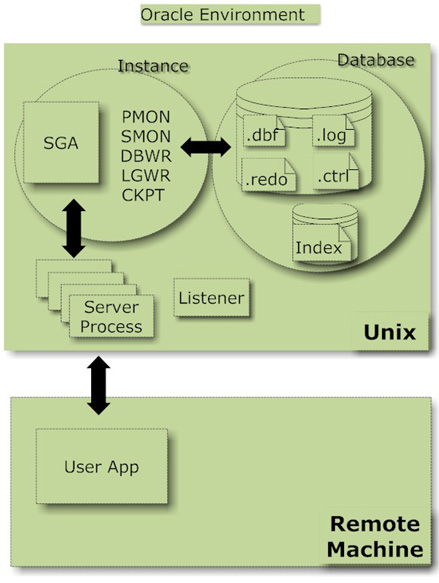What is Oracle? A Visual Definition
By: Wade Harvey
Historical Origins
In 1977, Larry Ellison and two of his friends, Bob Miner and Ed Oates, began a company named Software Development Laboratories, and they developed the original Oracle DBMS (Database Management System). They named the product Oracle after a code name project that they had worked on at a company called Ampex. In 1979, Software Development Laboratories was renamed to Relational Software Inc (RSI), and the RSI company was later renamed to Oracle Corporation in 1984.
Major Components of Oracle DBMS
An Oracle consists of a database and an instance.

A database includes all of the physical data files, control files, and redo log files that hold Oracles metadata and your data. Data files hold your actual data and indexes. Redo logs contain records of all changes that have been made. Control files hold important Oracle metadata. Control files contain all the information that instance needs to access a database.
An instance is a combination of the pool of physical memory (RAM) allocated to Oracle and the background processes that Oracle creates to use this memory pool. The RAM is called the SGA (System Global Area). RAM is used to cache data because RAM is about one thousand times faster that disk I/O. Here are the major processes that run in the background:
1. DBWR process that copies data in the RAM to the disk files
2. LGWR records changes applied to data in the redo log for recovery purposes in the event of a problem.
3. PMON Performance Monitor performs cleanup of failed user and server processes.
4. SMON System Monitor performs instance recovery in case server shuts down improperly.
5. CKPT Takes account whenever DBWR writes information from memory to disk.
Versions
The “i” in the version name emphasizes the internet functionality and the “g” emphasizes that the version is “grid-computing” ready.
| Date | Version | Features |
| 1979 | Oracle V2 | SQL queries and joins |
| 1983 | Oracle V3 | Commit, Rollback, Unix, Rewritten in C |
| 1984 | Oracle V4 | Read Consistency |
| 1985 | Oracle V5 | Distributed Queries |
| 1989 | Oracle V6 | ERP Financials, PL/SQL , row-level locking, hot backups |
| 1992 | Oracle V7 | referential integrity, stored procedures, triggers |
| 1997 | Oracle V8 | object-oriented and multimedia |
| 1999 | Oracle 8i | incorporated a native Java Virtual Machine (JVM) |
| 2001 | Oracle 9i | XML, Real Application Clusters (RAC), cluster database |
| 2003 | Oracle 10g | grids |
| 2007 | Oracle 11g |
Editions
| Edition | Features | Price |
| Standard Edition | Licensed by users or processors; 1-4 cpus |
$15,000 per CPU |
| Enterprise Edition | Increased performance and security | $40,000 per CPU |
| Standard Edition One | Scaled-down Standard Edition | $5,000 per CPU or $149 per user |
| Express Edition | Max of 4GB user data; single CPU, requires 150MB |
Free |
| Oracle Personal Edition | Same functionality as Enterprise Edition, but licensed to single-user developers | |
| Oracle Database Lite | Intended to run on mobile devices |
Client-Side Utilities
SQL*Plus – for creating and testing command-line SQL Queries and executing PL/SQL procedural programs.
Oracle Developer Suite – for developing database applications including the following developer tools:
- Forms Builder – for creating custom user applications
- Reports Builder – for creating reports for displaying, printing, and distributing summary data.
- Enterprise Manager – for performing database administration tasks such as creating new user accounts and configuring how the DBMS stores and manages data.
Further Study
There is an excellent set of study guide workbooks from Oracle University that you can get by clicking on this link: Oracle University Workbooks
